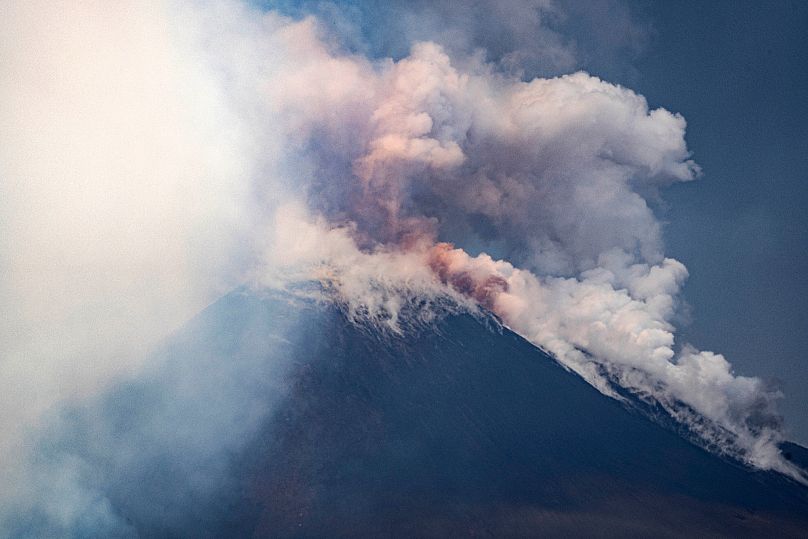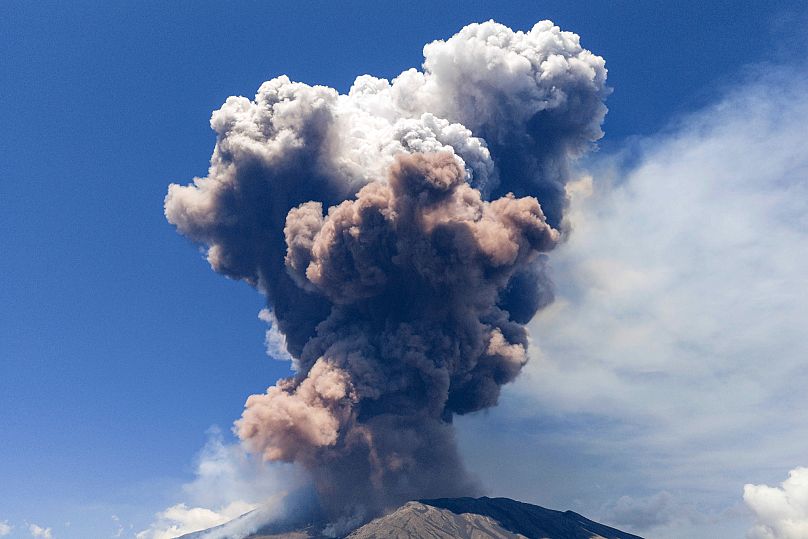On Monday, Mount Etna, which stands as the highest and most frequently erupting volcano in Europe, burst into activity over the Italian island of Sicily.
Video clips posted on social media depicted visitors running downslope as they attempted to escape an intensifying volcanic plume enveloping the mountaintop.
The Italian National Institute of Geophysics and Volcanology (IGNV) stated that the eruption commenced at 3:50 am local time on June 2nd, preceded by volcanic tremors which initiated around 10:00 pm on June 1st.
Volcanologists noted that Mount Etna has been witnessing strombolian eruptions escalating in intensity. Such events generally indicate a fairly moderate type of volcanic activity.
Around 11:30 AM local time, a pyroclastic flow consisting of scorching rocks, ash, and gases was captured on surveillance footage. The Italian National Institute for Environmental Protection and Sustainability (IGNV) stated that this event was likely caused by the collapse of materials from the north side of the South-East Crater.
This flow moved towards the northeast but does not seem to have extended beyond the boundary of the Valle del Leone, which is situated at the base of the summit craters on Mount Etna.
The explosive activity at the southeast crater produced three primary lava streams: one moving southward, another flowing eastward, and a third extending northward. Currently, all these lava flows are undergoing a cooling process. INGV reports that the release of ashes into the clouds seems to have ceased.
Mount Etna has a history of frequent eruptions dating back 3,000 years. The last major eruption in February sent a 3-kilometre river of lava flowing out of a crater called Bocca Nuova, meaning “new mouth”.
The eruption led to slight disturbances in transportation, as sections of Catania airport were shut down because of decreased visibility.
Will flights be affected by the eruption and is Catania airport closed?
Catania airport stands at the foot of Mount Etna, giving departing and arriving passengers a spectacular view of the volcano.
Catania–Fontanarossa Airport, commonly referred to as Vincenzo Bellini Airport, located on the eastern side of the island, is the preferred gateway for international travelers visiting Sicily.
Initially, the Volcanic Ash Advisory Centre in Toulouse, France—a key centre among nine worldwide tasked with tracking aviation hazards—issued a red alert for air travel. The warning level was later reduced to orange as the ash plume moved northwest and gradually dispersed.
The four main airports of Sicily—Catania–Fontanarossa (CTA), Comiso (CIY), Falcone–Borsellino (PMO), and Vincenzo Florio (TPS)—are all functioning normally without disruptions. Only slight delays occurred at the Catania airport early Monday.
You can obtain the latest details on arrivals and departures from the Catania Airport website .
Is it possible for me to receive compensation if my flight encounters disruption?
In case of disruptions at Catania Airport, airlines must provide you with an alternative flight or a refund if your flight is canceled or delayed by over three hours.
This applies only when they had the ability to prevent the disruption. However, it is not their responsibility in the event of a volcanic eruption.
Nevertheless, in most instances, airlines will make an effort to transport passengers to their ultimate destination.
It's prudent to invest in travel insurance since it allows you to reclaim unforeseen costs.
Is it still okay to travel to Sicily when Mount Etna is active?
Indeed, it remains perfectly safe to visit Sicily even when Mount Etna is active.
Local officials and community members are accustomed to managing the frequent eruptions of Mount Etna. Over the past half-decade, it has experienced numerous outbursts each year, yet this hasn’t deterred visitors; instead, tourism in Sicily continues to grow.
Even with regular eruptions, lava hasn’t made contact with adjacent towns since the 19th century. Mount Etna boasts over 200 craters, and whenever one of them erupts, dark volcanic debris falls onto the city of Catania below and numerous neighboring communities.
This causes inconvenience for residents, yet typically isn’t an issue for visitors. There are those who deliberately do this as well. ascend the volcano to witness an eruption , even as officials advise visitors to maintain a secure gap.
The mayor of Catania, Enrico Trantino, stated that everything was "under control and normal".
He told Italian newspaper Corriere della Sera As a result of surveillance by IGNV, the summit region was closed beforehand because of the impending eruption.



إرسال تعليق